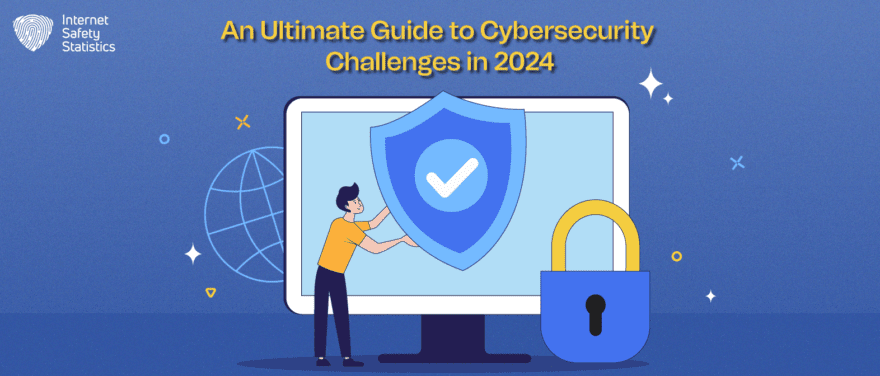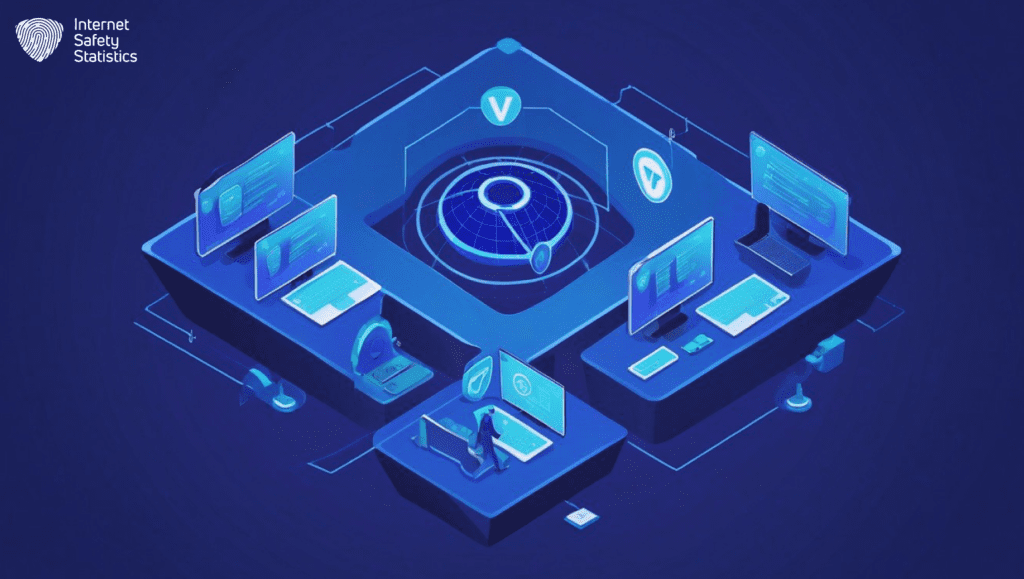
Cybersecurity challenges are the invisible threats that lie within the interconnected life we are leading today. From insidious phishing attempts to sophisticated network breaches, malicious actors lurk in the shadows, exploiting vulnerabilities and jeopardising the very foundations of our digital lives.
In this comprehensive analysis, we delve into the critical issue of cybersecurity challenges in 2023 and 2024. We shall dissect the evolving landscape of cyber threats, scrutinise the human factor and technological vulnerabilities, and explore the far-reaching consequences of cyberattacks.
Defining Cybersecurity: Protecting Our Digital Lives
Cybersecurity encompasses the practices, technologies, and processes employed to protect digital systems, networks, and data from unauthorised access, theft, disruption, ransomware or manipulation. This encompasses a broad range of threats, from simple malware and phishing attacks to sophisticated hacking efforts and nation-state espionage.
The importance of cybersecurity is paramount in today’s digital world, where virtually every aspect of our lives – from personal finances and communications to critical infrastructure and national security – relies on interconnected systems and stored data. Breaches of these systems can have devastating consequences, leading to financial losses, identity theft, privacy violations, sensitive data breaches, disruptions to essential services, and even physical harm.
Therefore, ensuring robust cybersecurity is not merely a technical concern but a vital component of safeguarding our individual and collective well-being in the modern age. The need for effective cybersecurity measures transcends industries and borders, requiring coordinated efforts from individuals, organisations, and governments to establish a secure and trustworthy digital environment.
Understanding Cybersecurity Challenges
This article sheds light on the complex and evolving challenge of cybersecurity in the digital age. We will delve into several key areas of concern that highlight the multifaceted nature of cyber threats and vulnerabilities:
Evolving Cybersecurity Measures
The cyber threat landscape is not static, particularly with the rising usage of IoT devices and cloud computing. Instead, it constantly evolves, with attackers developing increasingly sophisticated and diverse methods to compromise systems and exploit vulnerabilities. This section delves into several key trends characterising this evolution:
1. Increasing Sophistication: Gone are the days of simple script-kiddie attacks. Cybercriminals are employing advanced techniques, such as social engineering, multi-stage attacks, and exploiting complex software vulnerabilities. These attacks utilise specialised tools and automation, making them more difficult to detect and prevent.
2. Emerging Threats: New attack vectors and methodologies continually emerge, demanding constant vigilance and adaptation. For instance:
- Ransomware: It involves encrypting a victim’s data and demanding payment for its decryption, causing considerable financial and operational disruption.
- Zero-day vulnerabilities: These are previously unknown software flaws exploited by attackers before developers can patch them, posing a significant risk.
- AI-powered attacks: Artificial intelligence is increasingly employed by attackers to automate tasks, improve targeting accuracy, and evade detection by security systems.
- Ransomware attacks on Internet of Things (IoT) Devices: They are a growing threat with potentially devastating consequences. These attacks lock down devices, demanding payment for their release, and can disrupt critical infrastructure, steal sensitive data, and even endanger lives.
3. Targeted Attacks on Critical Infrastructure: Critical infrastructure – energy grids, transportation systems, and healthcare facilities – is increasingly targeted by attackers. These attacks can have vehement consequences, disrupting vital services and potentially causing physical harm.
The evolving landscape necessitates a proactive approach to cybersecurity. Continuously monitoring trends, updating systems, and educating users are crucial for staying ahead of attackers and mitigating the risks posed by this ever-changing digital threat landscape.
The Human Factor: A Crucial Element in Cybersecurity Challenges
While sophisticated technology and evolving vulnerabilities play a significant role in the cybersecurity field, the human element remains a critical and often overlooked factor. This section delves into the ways in which human error and social engineering can contribute to successful cyberattacks, especially on cloud infrastructure, while highlighting the importance of cybersecurity awareness and training.
1. Human Error as a Vulnerability: Simple mistakes, such as clicking on suspicious links, falling for phishing scams, or failing to use strong passwords, can create opportunities for attackers to gain access to systems and data. These inadvertent actions can bypass sophisticated security measures and leave individuals and organisations vulnerable.
2. Social Engineering: Deception’s Powerful Tool: Cybercriminals frequently employ social engineering techniques to deceive users into revealing sensitive data or taking actions that compromise security. These tactics, often involving impersonation, emotional manipulation, or leveraging trust, can be highly effective in exploiting human vulnerabilities.
3. Cybersecurity Awareness and Training: Equipping individuals and organisations with proper cybersecurity awareness and training is key for reducing the risks associated with human factors. By understanding common threats, safe online practices, and how to identify and report suspicious activity, individuals can become a stronger line of defence against cyberattacks.
4. Challenges of Insider Threats: Not all threats come from external sources. Malicious actors within an organisation, whether disgruntled employees or external collaborators with ill intent, can contribute to ransom attacks and pose a significant risk. Insider threats often have privileged access to systems and data, making them particularly difficult to detect and mitigate.
Addressing the human element as a cyber security challenge requires a multi-pronged approach. Comprehensive training programs, implementing strong authentication protocols, and fostering a culture of security awareness throughout organisations are essential steps towards minimising data breach risks associated with human vulnerabilities.
Technology Gap: Bridging the Divide in Our Digital Defences
The rapid pace of technological advancements presents their pros and cons on cybersecurity. While new technologies offer enhanced security features and functionalities, they also introduce new vulnerabilities that attackers can exploit. This section delves into cyber threats arising from this constant evolution and the need for continuous adaptation.
1. Keeping Pace with Innovation: The struggle to keep pace with the accelerating rhythm of technological progress poses a significant challenge. Attackers are quick to identify and exploit vulnerabilities in new technologies before developers can implement effective patches or security measures. This necessitates swift adaptation and continuous monitoring of emerging threats.
2. The Burden of Legacy Systems: Many organisations still rely on outdated software and legacy systems, often lacking adequate security features or updates. These systems represent significant vulnerabilities, as cybercriminals can leverage known exploits in older software versions for data breach or disrupt operations.
3. Securing Data in a Dynamic Landscape: Data protection strategies require constant re-evaluation in the face of technological advancements. Emerging attack vectors, such as cloud-based threats or the proliferation of smart devices, necessitate the adoption of dynamic and adaptable security solutions that can effectively safeguard sensitive information.
4. Continuous Investment in Security Technologies: Staying ahead of the curve demands ongoing investment in robust cybersecurity technologies. This includes implementing advanced malware detection and prevention systems, adopting encryption tools for data protection, and deploying vulnerability management solutions to identify and patch weaknesses before they can be exploited.
Closing the technology gap requires a commitment to continuous adaptation, proactive risk management, and prioritising investments in advanced security solutions. By acknowledging the challenges of a dynamic digital landscape and taking proactive steps to mitigate them, organisations can significantly strengthen their defences against ever-evolving cyber threats.
Globalised Threat Landscape: Navigating a Connected World’s Challenges

The digital landscape transcends national borders, with data and systems interconnected across continents. This interconnectedness presents distinct challenges and opportunities for cybersecurity, particularly in terms of security risk and potential data breach. This section delves into the key aspects of this globalised threat landscape:
1. Cross-border Data Flows and Vulnerability: The movement of data across borders poses unique challenges for data protection and breach response. Different countries have varying legal frameworks and regulations regarding data privacy and security, which can complicate investigations and recovery efforts in the event of an attack.
2. International Cooperation: A Necessary Weapon: Effective cybersecurity necessitates collaboration and information sharing between governments, law enforcement agencies, and private sector entities across national borders. Sharing threat intelligence, coordinating investigations, and harmonising cybercrime legislation are crucial for effectively combating global threats.
3. Nation-State Hacking: A Rising Threat: Nation-state actors increasingly engage in cyber attacks, information warfare, and infrastructure disruption, posing a significant threat to national security and critical infrastructure. The sophistication and resources of these actors necessitate heightened vigilance and coordinated defences on a global scale.
4. International Cybercrime Syndicates: Transnational criminal organisations have embraced the digital realm, engaging in cybercrime such as financial fraud, ransomware attacks, and data theft. These groups operate beyond national borders, requiring international cooperation and law enforcement collaboration to disrupt their activities and protect individuals and businesses.
5. Global Frameworks and Collaboration: Paving the Way for a Secure Future: Addressing the complexities of the globalised threat landscape demands the development of international frameworks and collaborative efforts. This includes harmonizing legal frameworks for cybercrime, establishing protocols for information sharing, and fostering coordinated responses to major ransom cyberattacks.
By identifying the challenges and opportunities presented by a globalised digital landscape, governments, businesses, and individuals can work together to strengthen cybersecurity measures and create a more secure and healthy online environment for all.
The ever-evolving digital landscape demands perpetual vigilance against cybersecurity challenges
. While defence systems bolster, attackers devise novel tactics. Collaboration, adaptation, and continuous innovation are our shields against malicious incursions. Only then can we navigate the digital world with confidence, securing both information and progress.
FAQS
What type of cybersecurity laws protect?
These laws protect against data breaches, cybercrime, and cyber espionage.
What is the international organisation for cyber security?
The ITU, a specialised agency of the United Nations, focuses on harmonising technical standards for information and communication technologies. It has a Global Cybersecurity Agenda to improve national and international cybersecurity capabilities.
How do I detect and remove malware?
Scan: Run a reputable antivirus scan in safe mode.
Isolate: Disconnect from the internet to prevent further spread.
Quarantine: Remove suspicious apps or files identified by the scan.
Clean Up: Reset browser settings and clear cache for good measure.
Update: Ensure all software has latest security patches installed.
What is an example of a data breach?
In 2017, hackers maliciously exploited a vulnerability at Equifax, compromising the personal data of over 147 million people. This major data breach caused financial losses, identity theft risks, reputational damage, and regulatory scrutiny.
